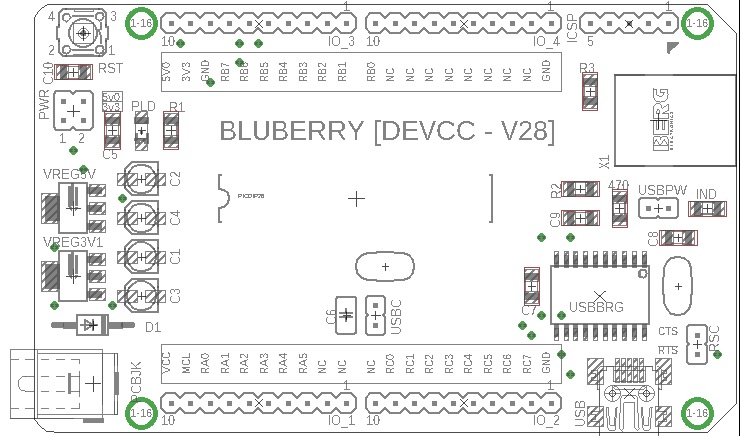Introduction
The BluBerry's are a family of embedded application development PCBs which cater to the wide variety of PIC family packages available. Since PICs are available in 8, 14, 18, 20, 28 and 40 PIN (amoung others in 64, 80 and 100 PINs) packages and owing to the
resources needed for each device in each family, a certain PCB is required. The BluBerry family therefore has a similar, standard architecture, but with differences between the various boards. The slight differences cater to the specific
requirements of the PIN package. This article will look at the 4 different PCBs and how they fit in to the embedded software development life cycle.
First Impressions
Shown below are the three varients for DIP packages in the BluBerry range. Each variant in the range caters to the specific PIN connections of the PIN package. The advantage offered by the
range then is an identical layout of the PCB, even though a different pakage is used. This enables a systems developer to take advantage of the forward and backwards compatibility of devices in
similar families. A new member of the family with fewer or more pins can be swopped out to replace the existing PCB.
In the table below, the individual specifications of the 3 variants are laid out. The DEVCC-V40 is also included as the PCB shares the same layout and features, with the expception that the
device is SMD soldered to the PCB.
| BluBerry Specifications |
Blu V18 |
Blu V20 |
Blu V28 |
DEVCC V40 |
| DC Jack |
YES |
YES |
YES |
YES |
| USB Powered Capable |
YES |
YES |
YES |
YES |
| Bootloader Capable |
NO |
NO |
YES |
YES |
| 3v3 | 5V0 |
YES |
YES |
YES |
YES |
| Package |
18 PIN DIP |
8, 14, 20 PIN DIP |
28 PIN DIP |
44 PIN TQFP |
| LED | Reset Button |
YES |
YES |
YES |
YES |
| Headers Ported |
A, B |
A, B, C |
A, B, C |
A, B, C, D, E |
| USB UART |
YES |
YES |
YES |
YES |
The above systems constitue the DEVCC range, catering to the PIC16F | PIC18F families of devices.
Learn more »
Lineart View
In the lineart view you can get a good idea of the PCB features. The PIC's pins are tracked to the same location for each variant. This means that if you were to replace the PCB for the
purpose of upgrading the project, the PCB is interchangeable with any existing wiring that you may have in place.

Skill up soon . . .
The BlueBerry (DEVCC) range of PIC development platforms offer a versatile and extensible range of options. You can switch beteen devices across families that Microchip provides with ease.
It has never been so easy to develop a system or product or just an idea you have bursting to take on a life of its own.